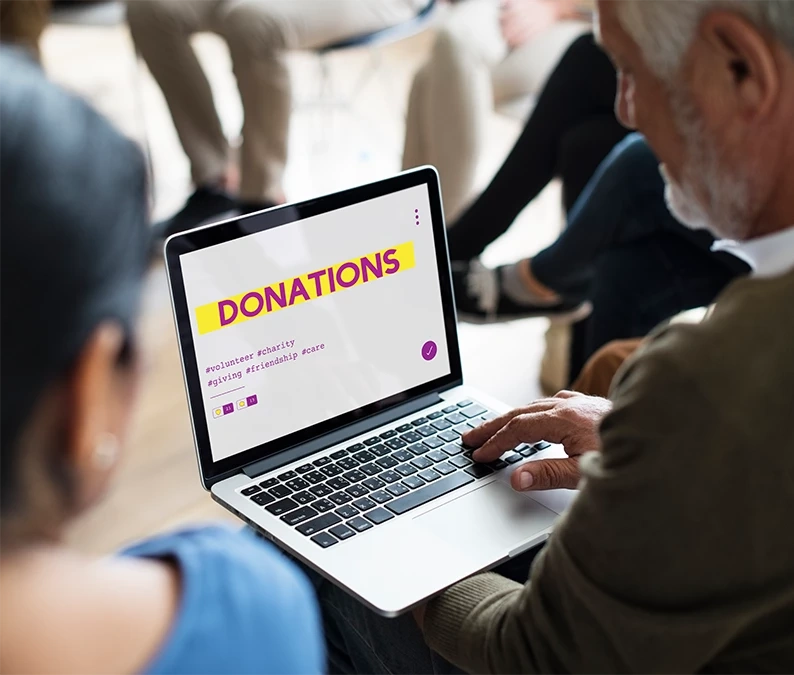10 Site Issues a Nonprofit Web Designer Can Fix
Recently updated on
A nonprofit web designer understands that a website is more than just a digital brochure—it's a vital tool for how mission-driven organizations communicate, operate, and grow. Still, many nonprofit websites start as quick, budget-conscious builds—managed on the fly, running on platforms that promise simplicity but fall short as needs evolve.
However, with the number of nonprofit organizations growing by over 1.4% annually for the past two decades, standing out has become harder, especially when competing for donor attention in an increasingly digital landscape. A dated or underperforming website can quietly limit engagement, not because of a lack of interest, but because the experience doesn't meet modern expectations.
These challenges aren't failures—they're growing pains. The mission has expanded, but the tools haven't kept up.
Below are ten common website pain points nonprofits face—and how thoughtful, quiet design decisions from someone who truly understands the nonprofit space can make a meaningful difference.

1. Keeping Website Updated Is a Struggle Without a Nonprofit Web Designer
Nonprofits often rely on small teams with many hats—program managers writing blog posts, fundraisers editing event pages, or volunteers uploading reports. But when updating content feels like navigating a minefield of confusing interfaces, outdated plug-ins, or unpredictable formatting, even small tasks become burdensome.
Good design starts behind the scenes. A content management system shaped around actual workflows (rather than a one-size-fits-all builder) empowers staff to manage content with confidence. Django's admin interface, when tailored to nonprofit teams, can offer a clean and intuitive experience that reduces training time and increases efficiency.
A content management system shaped around actual workflows empowers staff to manage content with confidence. That means updates occur more frequently, information remains current, and technical hurdles don't hinder digital momentum.
2. Solving Mobile Friction That Drives Visitors Away
Most of your visitors are arriving on mobile—whether they're donors checking out a campaign, volunteers signing up, or someone in need seeking support. And since you never know when or where they'll land on your site, it has to perform flawlessly on any device.
If your site loads slowly, displays poorly, or hides critical actions on a phone, it's not just inconvenient—it's exclusionary. A mobile-first design ensures that donation buttons, calls to action, and essential content are always transparent, fast, and functional. It's not a bonus feature; it's the baseline for building trust, expanding reach, and turning visits into meaningful action.
3. A Nonprofit Web Designer Makes Donating Feel Effortless
When visitors can't quickly figure out how to complete a task, whether it's making a donation or finding key information, they are less likely to stay. In fact, a Clutch survey found that 94% of users consider easy navigation the most essential feature in a website's user experience. For donors, especially, simplicity is non-negotiable. If the donation process is riddled with redirects, excessive fields, or unclear confirmations, it introduces friction and causes drop-offs.
A nonprofit web designer can eliminate these hurdles by building streamlined, branded donation flows or seamlessly integrating trusted tools. Even minor enhancements—like adding embedded forms, improving mobile performance, or syncing with your CRM—can significantly increase conversion rates. Platforms like Django make it possible to create flexible, scalable donation systems that adapt to your campaign goals. With a modular tech foundation, your site remains agile, growing without the need for costly rebuilds or risky overhauls.
4. Making Growth Feel Manageable—Not Risky
Every nonprofit grows. New programs launch, member portals get added, and event calendars become must-haves. But for many organizations, the idea of adding even one new feature triggers panic: Will this break our site? Can we afford the overhaul? Who's going to maintain it?
A nonprofit web designer understands that innovation shouldn't feel like a gamble. That's why scalable, modular platforms like Django are so valuable—they let nonprofits expand online services incrementally, without blowing the budget or rebuilding from scratch.
When your site is built with long-term adaptability in mind, it creates breathing room for strategic decisions. A nonprofit web designer helps lay the groundwork so future updates, integrations, or design changes feel like natural next steps, not disruptive resets.
5. Tackling Mysterious Site Slowdowns
Speed isn't just a luxury. Slow websites can negatively impact SEO, donor trust, and bounce rates. And in many cases, the culprit is unclear: outdated themes, overlapping plug-ins, or images that were never optimized.
Performance-oriented development—encompassing clean code, efficient asset handling, and minimal third-party bloat—keeps websites lean and responsive. The result? A user experience that feels seamless, fast, and professional—even when no one notices why.
6. A Nonprofit Web Designer Makes Information Easy to Find
If your visitors are calling to ask questions that should be easily found on your website, it’s a content structure issue. Navigation menus that don't match user expectations, vague labels, or poor hierarchy all contribute to digital dead ends.
Through thoughtful user experience (UX) planning, nonprofits can clarify what content matters most and make sure it's surfaced intuitively. Good UX isn't about flashy design. It's about ensuring that people can find what they need without hesitation.
7. Building Accessibility from Day One
Accessibility often gets overlooked until it becomes urgent. But ensuring that a site is usable for everyone—from screen reader users to keyboard navigators—is both a moral and practical imperative.
An accessible website complies with the Web Content Accessibility Guidelines (WCAG) set forth by the World Wide Web Consortium (W3C), the global standard for inclusive web design. These guidelines outline the structure of digital content to effectively serve users with visual, auditory, motor, and cognitive disabilities.
A nonprofit web designer builds with these standards in mind, implementing best practices like proper heading structure, alt text for images, high contrast ratios, semantic HTML, and logical tab flows. When accessibility is integrated into the design process from the outset, it doesn't feel like a retrofit. It feels like it was meant to be there all along.

8. Fixing Fragmented Systems
A seasoned nonprofit web designer understands that many organizations work with a digital patchwork of customer relationship management (CRM) systems, donor platforms, mailing tools, and volunteer databases. However, when these tools fail to communicate, nonprofit teams are left with manual processes, such as copying data between platforms, double-entering contact information, and manually reconciling reports. These inefficiencies slow momentum, and worse, they introduce serious security and accuracy risks.
Disjointed workflows often go hand in hand with outdated systems, which bad actors increasingly target. According to a survey by NTEN, 66% of nonprofit organizations view their current software setup as a significant challenge, often lacking the necessary integrations and safeguards for modern operations. This creates vulnerabilities—not only to efficiency but to donor privacy and financial oversight.
The solution isn't to pile on more tools, but to architect a smarter, unified foundation. With a secure, Django-powered backend, nonprofits can connect critical systems through APIs, automate syncing, and streamline reporting, reducing human error while improving visibility and compliance.
Integration isn't just operationally efficient; it's a form of digital self-defense.
9. A Nonprofit Web Designer Helps You Understand What's Working
Analytics can feel overwhelming, especially when the dashboard is cluttered with jargon and the insights aren't obvious. However, without data, it's challenging to determine which content resonates, which pages underperform, or how donors behave online.
Straightforward analytics setup, goal tracking, and simplified reporting can turn vague instincts into actionable strategies. Even a few well-configured metrics, such as donation form completion rate or program page bounce rate, can inform more intelligent decisions.
10. Ensuring the Website Reflects Your Mission
This is often the most emotional feedback we hear: "Our site doesn't feel like us." It could be too corporate, too templated, or outdated. It doesn't reflect the warmth, trust, or impact that defines the organization's work.
Great design tells a story without needing to explain itself. Through intentional layouts, compelling visuals, and brand-consistent tone, a website can quietly reinforce credibility and build connection, without shouting.
Why a Nonprofit Web Designer Makes All the Difference
A nonprofit web designer isn't just someone who builds pretty pages—they're a strategic partner in how your mission shows up online. The right designer helps remove friction, translate complex needs into intuitive interfaces, and ensure that your website grows alongside your organization, not despite it.
Great nonprofit websites don't shout. They don't overwhelm. They guide, support, and embody the values that underpin the mission. They're easy to update, welcoming on any device, and equipped to handle real-world nonprofit needs—from secure donations to volunteer signups to data integrations.
For organizations entering a new stage of growth—such as expanding programs, refining their digital strategy, or preparing for large-scale fundraising—a custom-built site can serve as the infrastructure that supports the next chapter.
In the end, what makes a website powerful isn't always what's on the surface—it's how quietly and reliably it supports the people behind it.
Need help with your mission (or website in general)? Let's talk about what's holding your site back—and what's possible on the other side.


 of value from this post, would you please take a sec and share it? It really does help.
of value from this post, would you please take a sec and share it? It really does help.